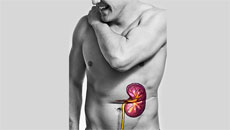Ten-year-old Colin jumps with joy at the prospect of a picnic with his friends, but suddenly a quick despair takes over; for Colin and thousands of other children like him, any outdoor activity is also synonymous with sneezing, wheezing, and itchy misery; sometimes more serious reactions – turning a fun trip into misery. So what do these symptoms symbolize? Allergies – usually triggered with the onset of the summer season.
Published research reveals that one in six Canadians suffers from hay fever or seasonal allergy rhinitis (inflammation of the nasal tract). The allergy season usually begins from early spring and lasts until the onset of winters. A Canadian Allergy, Asthma, and Immunology Foundation survey revealed that as many as 10 million Canadians suffer from allergy symptoms; of these women tend to suffer more than men.
The survey also reveals that 55 per cent of Canadians admit that allergies hamper their productivity; and almost a quarter limit outdoor activities to prevent the trigger of any symptoms. Stuti, who works with a leading bank says, “It gets very bad, I sneeze all day; and considering I deal with the public, the constant sneezing becomes an embarrassment.” Martha, a resident of Vancouver suffers from severe symptoms, “I suffer from pollen allergy; I get a stuffy nose and swelling during spring-summer. I can’t breathe, I can’t sleep, and it’s terrible.”
The survey further illustrated that Ontario has the highest rate of seasonal allergies, while the Atlantic provinces have the lowest. One might wonder why the sneezing, as the weather warms up. “The advent of summer causes reactions in the human body, called Mast Cells, which produce histamine. It leads to nasal discharge (water from the nose), nasal congestion and sometimes cough, and sore throat.
It mostly affects children and adults, and not the older population as much,” explains Dr. J.L. Makhija, an allergist, who specializes in Immunotherapy. Everyone’s immune system defines and reacts differently to allergens. When an allergen enters the body, which is predisposed to allergies, it triggers an immune reaction and allergen-specific antibodies are produced. These antibodies migrate to mast cells lining the nose, eyes and lungs. When the allergen-like pollen, mold enters the body, mast cells release histamine that irritates and inflames the moist membranes linings and produce symptoms of an allergic reaction – sneezing, itching, and watery eyes.
Main Allergens
Let’s also understand the main substances that cause allergies:
Pollen: Of all the summer allergens, pollen is the most common. Though, always present in the environment, its quantity increases with dry conditions. “Pollens are present in grasses, weeds, trees and ragweed,” adds Makhija. “Before the leaves come out, it’s mostly tree pollen; in late spring, it’s grass pollen, by late July-August, it’s weed pollen.”
Researchers and experts feel there has been an outburst of pollen in recent years, and it leads to the maximum number of infections. Pollen allergy leads to symptoms like watery nose, cough, sneezing, itchy throat and nasal congestion.
Some steps that can be taken to prevent pollen allergy are:
• Keeping windows and doors closed
• Drying clothes in the dryer and not hanging them outdoors
• Avoiding use of fans
• Exercising indoors on days when pollen level outside is relatively higher
• Not allowing pets in the bedroom if they have spent a lot of time outside
• Considering replacing carpets with hardwood floors
• Wearing sunglasses and a brimmed hat when venturing out
• Keeping windows closed while driving, and switching on the air conditioner
Mold: It is a type of fungus; present year-round both indoors as well as outdoors, breaks down plant and animal matter. Although there are several types of molds, only a few trigger allergic reactions. One of the most common molds is Alternaria, which leads to hay fever and in some worse cases, asthma. “People mostly don’t understand the problem they have,” explains Dr. Sandhya Shukla, chief medical officer at Buffalo General Hospital, New York. “They have allergic reactions like chest tightness, lot’s of upper respiratory problems and sinus drainage; problems that can change a person’s life – it could last as long as over a year.”
A person with mold allergy should:
• Always wear a mask when gardening or mowing the lawn
• Ensure there is no dampness in the house, as that may be an ideal breeding ground for molds
• Fix any leakages in the house immediately, regularly dehumidify the house
Stings: Although less common, stings can be extremely dangerous. Stings from insects, bugs and flies that surface with the heat like bees, mosquitoes, certain ants, ticks, yellow jackets or hornets. Stings can result in redness, itching, swelling or to a severe condition known as the Anaphylaxis.
The best way to avoid getting stung are:
• Use insect repellant
• Avoid walking barefoot in grass
• Do not drink from open cans where insects might have touched
• Keep food covered, especially outdoors
Sunlight: The most common form of sun allergy is known as polymorphic light eruption. In an effort to overload our bodies with Vitamin D, we might get exposed to too much sun, which can cause sunburn, skin texture changes and skin cancers. Symptoms of sunburn include painful and reddened skin. Severe sunburn results in swelling, blisters; in some cases it results in fever and weakness. Sunscreens are quick and cheap solutions to provide some protection from exposure to sun.
Food Allergies:Some people are allergic to seasonal fruits like watermelon, celery and melon. Known as Oral Allergy Syndrome, it results in swelling of the mouth, itching and tingling. However, these allergies aren’t life threatening and people can avoid them by staying away from that particular food/fruit.
Makhija further explains, “We divide allergies into three categories – first are pollens, then the inhalants that include grasses, trees, weeds and ragweed, and the third one is food. Of these the first two are hard to avoid, and they are relatively tougher to treat, but food allergies can be easily avoided with a little caution and awareness.”
Diagnoses and Cure
The first step is maintaining a diary – keep a track of the symptoms you have; make notes like when did they appear or a particular time when symptoms aggravate. This way, you’ll be able to eliminate some percent of the problem at your end.
The next step is visiting a doctor; there are skin and blood tests to identify substances that are causing allergies. “We put a scratch on the patient’s arm, apply the medicine and wait for 30 minutes, depending on the body’s allergy, it will swell up, and we know what kind it is,” says Makhija pointing to some bottles kept on a tray.
While at times tough to avoid, most of these allergies can be treated with simple pills or anti-allergy medicines called antihistamines, which are available off the counter at your local drug store but it can get tricky if the human body gets a little too familiar with the drug rendering it to be ineffective. “There are allergy pills like Reactine, Claritin and Aerius, which we prescribe to patients, sometimes a singular tablet of 10 mg, but the problem is that sometimes these medicines work, and at other times they don’t. A patient’s body gets used to them, and stops responding the way it should,” clarifies Makhija.
Immunotherapy
Also called desensitization, it aims to cure patients whose allergies aren’t controlled by symptomatic treatments. They are shots that help your body get used to allergens or substances that trigger an allergy. Immunotherapy does not treat allergies, it helps with symptoms, which get better and they may not have allergic reactions often. Makhija, who practices Immunotherapy explains, “We inject very low doses of whatever the patient is allergic to, and then slowly increase the shots. Patients show signs of recovery usually after 3-4 weeks of receiving the shots. It isn’t a very expensive either, costs $300/per year, which is nothing compared to the way they suffer.”
Alternative Treatment
If your allergies are driving you nuts, but you really don’t want to go with conventional medications, or maybe you’ve tried over-the-counter meds or even prescription ones, but you’re not getting the relief you need, there are some alternative treatment options.
Acupuncture, the traditional Chinese medicine, can be an effective cure. Tiny needles are inserted just under the skin at specific points in the body used to reduce symptoms. The American journal Annals of Internal Medicine recently conducted research to study the effect of Acupuncture on Seasonal Allergic Rhinitis, and examined 422 people with seasonal allergies, and out of these, a few were given real acupuncture treatment. After two months, participants receiving acupuncture treatments showed greater signs of improvement in allergies. The authors of the study conclude, “The effectiveness of acupuncture for (seasonal allergies) compared with other anti-allergic interventions and the possible underlying mechanisms of any effect, including context effects need to be addressed in further research.”
Dr. B.K. Singh, an Acupuncture specialist for the past 44 years, who is the President and Dean of International Academy of Bhupendra Techniques explains, “During a regular anti-allergy treatment, the medicine enters the body system and stops antigen reaction; the doctors keep repeating the medicine. It’s like a tap is open and water is coming in the ditch, keep emptying the ditch. What I do, is try and find out what is causing the allergy. I try to stop the tap that is, just eliminate the source of the problem.”
“It is a very individualized treatment, every patient requires different treatment as everyone’s body reacts differently, but it’s a very effective method,” he adds.
Martha, a patient of Singh’s, exclaims with joy, “I was suffering a lot, but I was treated by Dr. Singh, and it was a miracle in the first sitting – I felt relief. Now after three sittings, I am able to breathe, and sleep at night. It is amazing.”
“Acupuncture increases the body’s immune system, increases resistance to fight with infection, not only allergy, but any other problem,” explains Singh.
Other available options include honey, saline nasal rinse, steam inhalation, stinging nettle leaf and homoeopathic alternatives. In conclusion, while there are several variants of allergies, there are equally diverse options available for cures. Awareness around how our body reacts amidst change of seasons can make all the difference helping us enjoy the outdoors and all that nature has to offer.
By Ritu Dixit






